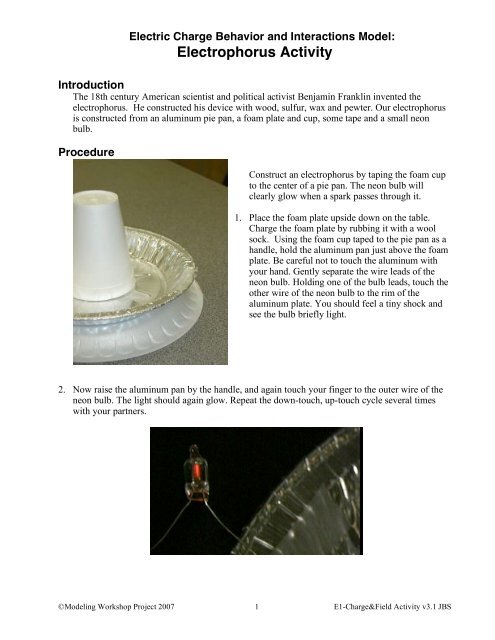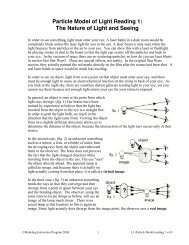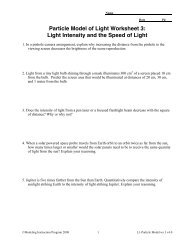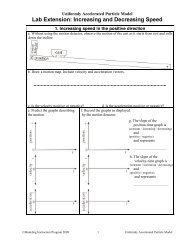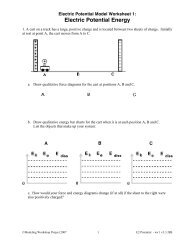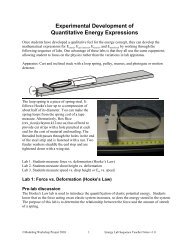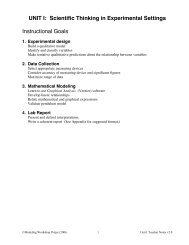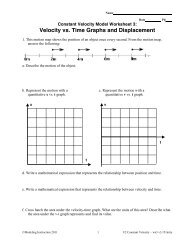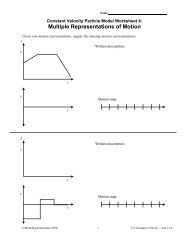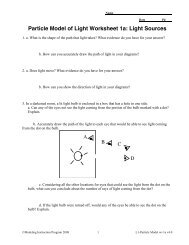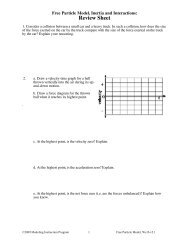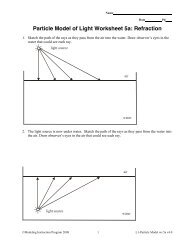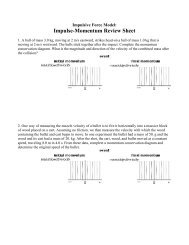Electrophorus, Conductors and Insulators - Modeling Physics
Electrophorus, Conductors and Insulators - Modeling Physics
Electrophorus, Conductors and Insulators - Modeling Physics
Create successful ePaper yourself
Turn your PDF publications into a flip-book with our unique Google optimized e-Paper software.
Electric Charge Behavior <strong>and</strong> Interactions Model:<br />
<strong>Electrophorus</strong> Activity<br />
Introduction<br />
The 18th century American scientist <strong>and</strong> political activist Benjamin Franklin invented the<br />
electrophorus. He constructed his device with wood, sulfur, wax <strong>and</strong> pewter. Our electrophorus<br />
is constructed from an aluminum pie pan, a foam plate <strong>and</strong> cup, some tape <strong>and</strong> a small neon<br />
bulb.<br />
Procedure<br />
Construct an electrophorus by taping the foam cup<br />
to the center of a pie pan. The neon bulb will<br />
clearly glow when a spark passes through it.<br />
1. Place the foam plate upside down on the table.<br />
Charge the foam plate by rubbing it with a wool<br />
sock. Using the foam cup taped to the pie pan as a<br />
h<strong>and</strong>le, hold the aluminum pan just above the foam<br />
plate. Be careful not to touch the aluminum with<br />
your h<strong>and</strong>. Gently separate the wire leads of the<br />
neon bulb. Holding one of the bulb leads, touch the<br />
other wire of the neon bulb to the rim of the<br />
aluminum plate. You should feel a tiny shock <strong>and</strong><br />
see the bulb briefly light.<br />
2. Now raise the aluminum pan by the h<strong>and</strong>le, <strong>and</strong> again touch your finger to the outer wire of the<br />
neon bulb. The light should again glow. Repeat the down-touch, up-touch cycle several times<br />
with your partners.<br />
©<strong>Modeling</strong> Workshop Project 2007 1 E1-Charge&Field Activity v3.1 JBS
Discussion & Further Exploration<br />
1. The original source of charge for the electrophorus is the charged foam plate. How does this<br />
charge come about<br />
2. What kind of electric charge is on the foam plate<br />
When Benjamin Franklin rubbed a glass rod with silk, he called the charge on the glass rod<br />
positive, (+) so to be consistent with history, we will do the same.<br />
Record your observations below as you use a glass rod, silk, <strong>and</strong> charged tapes to determine the<br />
kind of charge on the foam.<br />
3. The bulb can be lit when touched to the aluminum plate. Can the bulb be lit when touched to the<br />
foam plate What is the difference between how the foam <strong>and</strong> the aluminum “hang on” to their<br />
charge<br />
4. Does charge move more easily in the foam or in the aluminum Why is a foam cup used as a<br />
h<strong>and</strong>le on the aluminum plate<br />
5. Use the following set of diagrams to illustrate the distribution <strong>and</strong> movement of charge during an<br />
up-<strong>and</strong>-down cycle of the electrophorus.<br />
a. The uncharged foil plate is placed upon the charged foam plate. Draw the charges on the foam<br />
plate. Draw the charges on the foil plate keeping in mind the forces exerted on them by the charges<br />
from the foam plate.<br />
©<strong>Modeling</strong> Workshop Project 2007 2 E1-Charge&Field Activity v3.1 JBS
. The wire from bulb is touched <strong>and</strong> lights while the foil plate sits on the foam plate. Does the<br />
charge on the foam plate change from the previous situation Draw the charges on the foam plate.<br />
How will touching the bulb affect the charges on the foil plate Draw the charges on the foil plate.<br />
What is the net charge of the pie pan after the bulb lights<br />
c. The aluminum plate is lifted away from the foam plate using the foam cup h<strong>and</strong>le. How will<br />
lifting the foil plate away from the foam plate affect the charges on the foil plate Draw the<br />
distribution of charge on the foil plate.<br />
d. The wire from the light bulb is touched a second time <strong>and</strong> lights briefly. How will touching<br />
the bulb affect the charges on the foil plate Draw the charges on the foil plate. What is the net<br />
charge of the pie pan after the bulb lights<br />
©<strong>Modeling</strong> Workshop Project 2007 3 E1-Charge&Field Activity v3.1 JBS
6. Closely examine the Neon bulb during the down-touch, up-touch cycle. Only one side of the<br />
Neon bulb will glow at a time, <strong>and</strong> this depends on whether the Aluminum plate is up or down.<br />
Which side of the bulb (most positive or most negative) glows<br />
7. The down-touch, up-touch cycle can be repeated almost indefinitely or until the charge on the<br />
foam leaks away. Since the charge on the foam is not "used up," where does the energy to light<br />
the bulb repeatedly come from in this device<br />
8. Suppose the foam plate was replaced by an object that acquired a charge opposite to that of the<br />
foam. Would the electrophorus still work What would be different<br />
©<strong>Modeling</strong> Workshop Project 2007 4 E1-Charge&Field Activity v3.1 JBS


